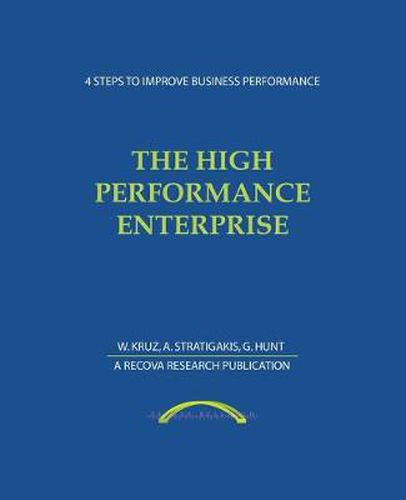Readings Newsletter
Become a Readings Member to make your shopping experience even easier.
Sign in or sign up for free!
You’re not far away from qualifying for FREE standard shipping within Australia
You’ve qualified for FREE standard shipping within Australia
The cart is loading…






This title is printed to order. This book may have been self-published. If so, we cannot guarantee the quality of the content. In the main most books will have gone through the editing process however some may not. We therefore suggest that you be aware of this before ordering this book. If in doubt check either the author or publisher’s details as we are unable to accept any returns unless they are faulty. Please contact us if you have any questions.
This book presents, as a how-to guide, a compelling methodology for improving the operational and financial performance of a firm. The book focuses on the optimum utilization of capital assets and human resources to support the firm’s business strategy and, therefore, gain a competitive advantage. It complements publications on the Balanced Scorecard by providing rather detailed sets of performance metrics applicable to Supply Chain, Customer Relationship Management, and Intellectual Capital improvement efforts. Managers involved in business improvement programs will benefit from the development of performance metrics for intellectual capital. MBA students will find especially useful the concise description of the best practices and issues affecting enterprise performance today.
Reviews Finally, consideration for non-financial assets handled in a non-financial manner. A coming together of several current management concepts, along with a way to measure and evaluate their value to the company. A useful reference for building, implementing and evaluating a plan of improved efficiency. L. Sehr
RA/AVP, Bank of America, San Jose, California This book provides a good overview of important financial and process redesign concepts that can influence business performance. This resource covers a broad range of ideas from continuous improvement, business strategies, balanced scorecards and value measurement tools. Non-financial persons will find this especially helpful, as information is presented in a non-technical manner, a quick read and intuitively links each idea or concept. David Bell
Senior Manager, Guidant, Inc., Santa Clara, California The High Performance Enterprise is written in a very readable and concise language. The authors manage to explain in a very direct way the relationship between enterprise high performance and each of the four steps to achieving it; all this, without getting bogged down with the details on specific techniques and practices that are generally known in the industry. The discussion stays focused on the importance of metrics and simulation and their link to overall financial/accounting concepts that gauge the value of the enterprise and its performance. Because the book touches on, and gives examples of, all major functional aspects of an enterprise, I would recommend it for use in an undergraduate strategic management or capstone course in business administration program. The book would be particularly useful in an MBA course. George Guim Ed.D.
Head of Business Administration Department
The National Hispanic University, San Jose, California
$9.00 standard shipping within Australia
FREE standard shipping within Australia for orders over $100.00
Express & International shipping calculated at checkout
This title is printed to order. This book may have been self-published. If so, we cannot guarantee the quality of the content. In the main most books will have gone through the editing process however some may not. We therefore suggest that you be aware of this before ordering this book. If in doubt check either the author or publisher’s details as we are unable to accept any returns unless they are faulty. Please contact us if you have any questions.
This book presents, as a how-to guide, a compelling methodology for improving the operational and financial performance of a firm. The book focuses on the optimum utilization of capital assets and human resources to support the firm’s business strategy and, therefore, gain a competitive advantage. It complements publications on the Balanced Scorecard by providing rather detailed sets of performance metrics applicable to Supply Chain, Customer Relationship Management, and Intellectual Capital improvement efforts. Managers involved in business improvement programs will benefit from the development of performance metrics for intellectual capital. MBA students will find especially useful the concise description of the best practices and issues affecting enterprise performance today.
Reviews Finally, consideration for non-financial assets handled in a non-financial manner. A coming together of several current management concepts, along with a way to measure and evaluate their value to the company. A useful reference for building, implementing and evaluating a plan of improved efficiency. L. Sehr
RA/AVP, Bank of America, San Jose, California This book provides a good overview of important financial and process redesign concepts that can influence business performance. This resource covers a broad range of ideas from continuous improvement, business strategies, balanced scorecards and value measurement tools. Non-financial persons will find this especially helpful, as information is presented in a non-technical manner, a quick read and intuitively links each idea or concept. David Bell
Senior Manager, Guidant, Inc., Santa Clara, California The High Performance Enterprise is written in a very readable and concise language. The authors manage to explain in a very direct way the relationship between enterprise high performance and each of the four steps to achieving it; all this, without getting bogged down with the details on specific techniques and practices that are generally known in the industry. The discussion stays focused on the importance of metrics and simulation and their link to overall financial/accounting concepts that gauge the value of the enterprise and its performance. Because the book touches on, and gives examples of, all major functional aspects of an enterprise, I would recommend it for use in an undergraduate strategic management or capstone course in business administration program. The book would be particularly useful in an MBA course. George Guim Ed.D.
Head of Business Administration Department
The National Hispanic University, San Jose, California